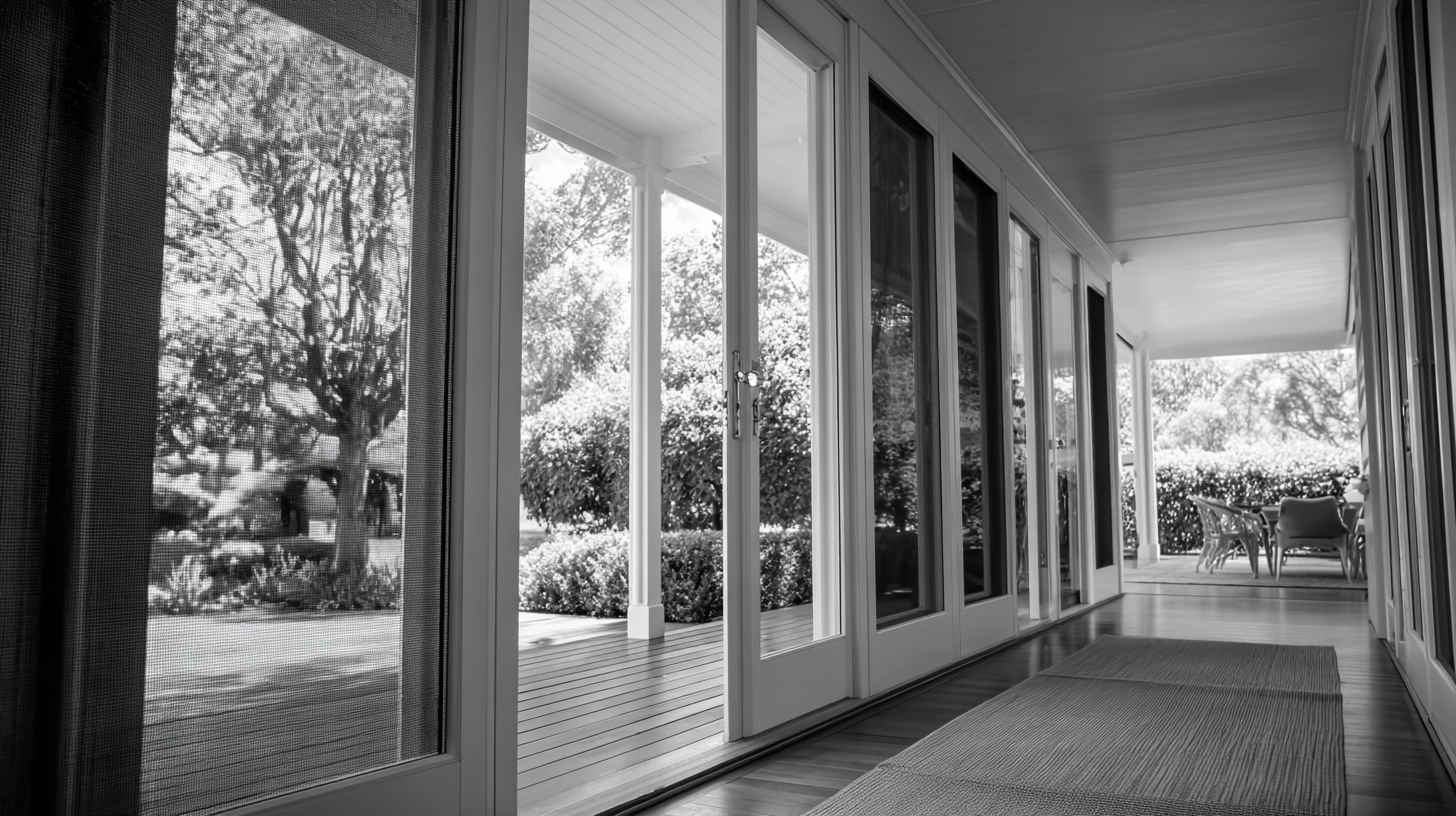- Call Us 03 8353 2113
- Mail Us sale@laxmidoor.com
Blog
Enhancing Home Comfort: The Impact of Fly Screen Doors on Energy Efficiency and Indoor Air Quality
In the pursuit of a more comfortable living environment, homeowners are increasingly turning their attention to innovative solutions that enhance both energy efficiency and indoor air quality. One such solution gaining popularity is the installation of Fly Screen Doors. These versatile fixtures not only serve as a barrier against pests, allowing fresh air to circulate freely throughout the home, but they also play a crucial role in reducing reliance on artificial cooling and heating systems.

Benefits of Fly Screen Doors for Home Energy Efficiency
Fly screen doors are an effective solution for enhancing home energy efficiency while improving indoor air quality. By allowing fresh air to circulate freely, these screens help to maintain comfortable temperatures within the home without relying heavily on air conditioning systems. This natural ventilation can significantly reduce energy consumption, leading to lower energy bills and a diminished environmental footprint.
In addition to their energy-saving benefits, fly screen doors also contribute to better indoor air quality. They act as a barrier against insects and pollutants, allowing homeowners to keep windows open without the worry of pest infiltration. This not only fosters a healthier living environment but also reduces the reliance on chemical insecticides that can compromise indoor air quality. Overall, integrating fly screen doors into a home can create a more comfortable and energy-efficient living space.

Impact of Fly Screen Doors on Indoor Air Quality Improvement
Fly screen doors are increasingly recognized for their role in enhancing indoor air quality, particularly in residential settings. According to a study published by the American Society of Heating, Refrigerating and Air-Conditioning Engineers (ASHRAE), well-ventilated homes can reduce indoor pollutants by up to 50%. Fly screen doors allow for natural airflow while effectively blocking insects and outdoor debris, creating a healthier indoor environment.
Moreover, the U.S. Environmental Protection Agency (EPA) reports that proper ventilation can significantly lower levels of indoor air toxins, which include volatile organic compounds (VOCs) that can accumulate from household products. By incorporating fly screen doors, homeowners can achieve a balance between fresh air circulation and pest control, ultimately improving their living conditions.
Additionally, the use of fly screens can contribute to maintaining optimal humidity levels, which is crucial in preventing mold growth, a common indoor air quality issue. Implementing such solutions not only enhances comfort but also promotes a more sustainable and healthier home environment.
Role of Fly Screen Doors in Reducing HVAC System Strain
Fly screen doors play a pivotal role in optimizing indoor air quality while simultaneously reducing the strain on HVAC systems. By allowing fresh air to circulate freely while keeping out insects, these doors create a balanced indoor environment, leading to improved air quality. This natural ventilation helps maintain comfortable temperatures, ultimately reducing the need for air conditioning. As a result, your HVAC system operates less frequently, leading to lower energy consumption and extended system lifespan.
**Tips for Maximizing Efficiency with Fly Screen Doors:**
1. Ensure proper installation of fly screen doors to prevent air leaks, which can undermine their effectiveness.
2. Consider choosing magnetic fly screen doors for easy access in high-traffic areas while still maintaining airflow.
3. Regularly clean the fly screens to ensure unobstructed airflow, enhancing their performance and efficiency.
With a reduced reliance on heating and cooling systems, homeowners can expect not only a more comfortable living space but also significant savings on energy bills. Fly screen doors are an essential addition to any energy-efficient home strategy, seamlessly combining comfort with sustainability.
Enhancing Home Comfort: The Impact of Fly Screen Doors on Energy Efficiency and Indoor Air Quality
| Dimension | Measurement | Impact on Energy Efficiency | Impact on Indoor Air Quality |
|---|---|---|---|
| Temperature Regulation | Average decrease of 3°C | Reduces HVAC cooling load by 15% | Improves thermal comfort |
| Humidity Control | Relative humidity maintained at 50%-60% | Reduces strain on dehumidifiers | Helps prevent mold growth |
| Insect Prevention | Reduction in insect intrusion by 90% | Less need for chemical pest control | Enhances overall freshness of air |
| Air Circulation | Improved air flow rates up to 30% | Less reliance on air conditioning | Fresher indoor air quality |
| Energy Savings | Annual savings of $150-$200 | Reduces energy consumption by 20% | Lower emissions from HVAC systems |
Comparing Different Types of Fly Screen Doors for Maximum Efficiency
When it comes to enhancing home comfort, the choice of fly screen doors can significantly influence energy efficiency and indoor air quality. Different types of fly screen doors offer various benefits, catering to both functional and aesthetic preferences. Traditional mesh screens provide basic protection against insects while allowing ventilation. However, newer models, such as retractable and magnetic screens, offer added convenience by seamlessly blending into the home’s architecture when not in use, thus enhancing the overall aesthetic appeal.
Additionally, advanced materials, like solar mesh screens, play a crucial role in temperature regulation. These screens not only keep insects out but also block harmful UV rays, helping to reduce indoor temperatures and lower air conditioning costs. Furthermore, options such as contactless or automatic fly screen doors facilitate easier access while promoting airflow, which is essential for maintaining high indoor air quality. By comparing the differences in design and materials, homeowners can select fly screen doors that optimize their energy savings and create a more comfortable living environment.

Maintenance Tips for Maximizing the Benefits of Fly Screen Doors
Maintaining fly screen doors is essential to maximize their benefits for energy efficiency and indoor air quality. Regular cleaning can enhance airflow, which, according to the U.S. Department of Energy, can save homeowners up to 30% on their energy bills when natural ventilation is optimized. By ensuring that the screens are free of dust and debris, homeowners can promote better circulation, reducing the reliance on air conditioning and thus lowering energy costs.
Additionally, inspections for damage or wear are crucial. A 2021 report from the American Society of Heating, Refrigerating and Air-Conditioning Engineers (ASHRAE) emphasized that well-maintained fly screens not only filter out insects and pollutants but also contribute to better indoor air quality by allowing fresh air to flow in while keeping contaminants out. Homeowners should also consider re-screening or replacing their fly screens every few years to ensure maximum performance. Implementing these maintenance tips can significantly enhance home comfort by creating a healthier and more energy-efficient living environment.
Related Posts
-

Exploring Industry Standards for the Best Fly Screen Doors
-

Ultimate Guide to Choosing the Best Shop Shutters for Your Business Needs Based on Industry Insights
-

Comprehensive Guide to Security Doors and Screens Features and Optimal Selection for Global Buyers
-

Discover the Ultimate Protection with Innovative Steel Security Doors for Your Property Safety
-

How to Select Top Manufacturers for Best Security Doors Installed: Comprehensive Solutions Guide
-

Ultimate Checklist for Choosing the Right Roller Shutters for Your Business Needs
